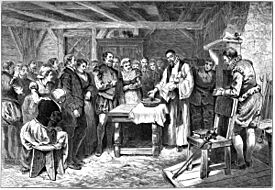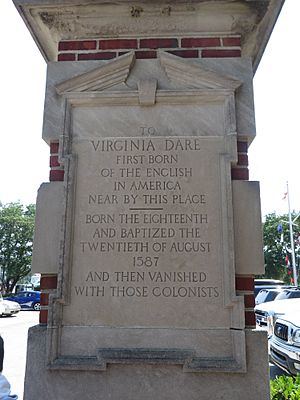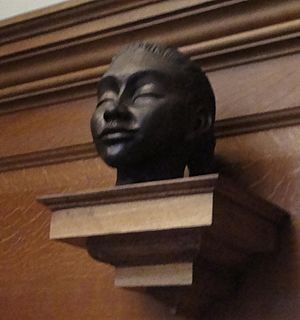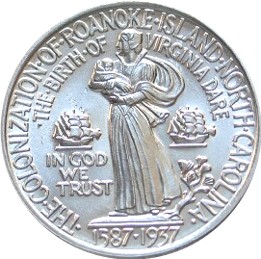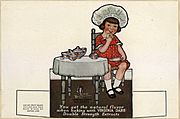Virginia Dare facts for kids
Quick facts for kids
Virginia Dare
|
|
|---|---|
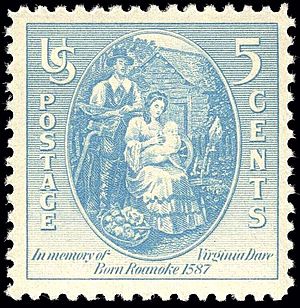
US postage stamp issued in 1937, the 350th anniversary of Virginia Dare's birth
|
|
| Born |
Virginia Dare
August 18, 1587 Roanoke Colony (present-day North Carolina)
|
| Known for | first English child born in the New World |
| Parents |
|
Virginia Dare (born August 18, 1587, in Roanoke Colony, date of death unknown) was the first English child born in a New World English colony.
What became of Virginia and the other colonists remains a mystery. The fact of her birth is known because John White, Virginia's grandfather and the governor of the colony, returned to England in 1587 to seek fresh supplies. When White eventually returned three years later, the colonists were gone.
During the past four hundred years, Virginia Dare has become a prominent figure in American myth and folklore, symbolizing different things to different groups of people. She has been featured as a main character in books, poems, songs, comic books, television programs, and films. Her name has been used to sell different types of goods, from vanilla products to soft drinks, as well as wine and spirits. Many places in North Carolina and elsewhere in the Southern United States have been named in her honor.
Contents
Biography
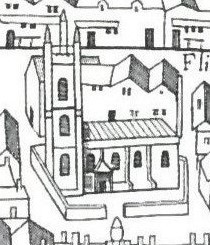
Virginia Dare was born in the Roanoke Colony in what is now North Carolina in August 1587, the first child of English parents born in the New World. "Elenora, daughter to the governor of the city and wife to Ananias Dare, one of the assistants, was delivered of a daughter in Roanoke".
Little is known of the lives of either of her parents. Her mother Eleanor was born in London around 1563, and was the daughter of John White, the governor of the ill-fated Roanoke Colony. Eleanor married Ananias Dare (born c. 1560), a London tiler and bricklayer, at St Bride's Church on Fleet Street in the City of London. He, too, was part of the Roanoke expedition. Virginia Dare was one of two infants born to the colonists in 1587 and the only female child known to have been born to the settlers.
Nothing else is known of Virginia Dare's life, as the Roanoke Colony did not endure. Virginia's grandfather John White sailed for England for fresh supplies at the end of 1587, having established his colony. Because England's war with Spain brought about a pressing need for ships to defend against the Spanish Armada, he was unable to return to Roanoke until August 18, 1590, by which time he found that the settlement had been long deserted. The buildings had collapsed and "the houses [were] taken down". Worse, White was unable to find any trace of his daughter or granddaughter, or indeed any of the 80 men, 17 women, and 11 children who made up the "Lost Colony".
Mystery of the "Lost Colony" (Roanoke)

Nothing is known for certain of the fate of Virginia Dare or her fellow colonists. Governor White found no sign of a struggle or battle. The only clue to the colonists' fate was the word "Croatoan" carved into a post of the fort, and the letters "Cro" carved into a nearby tree. All the houses and fortifications had been dismantled, suggesting that their departure had not been hurried. Before he had left the colony, White had instructed them that, if anything happened to them, they should carve a Maltese cross on a tree nearby, indicating that their disappearance had been forced. There was no cross, and White took this to mean that they had moved to Croatoan Island (now known as Hatteras Island), but he was unable to conduct a search.
There are a number of theories regarding the fate of the colonists, the most widely accepted one being that they sought shelter with local Indian tribes, and either intermarried with the natives or were killed. In 1607, John Smith and other members of the successful Jamestown Colony sought information about the fate of the Roanoke colonists. One report indicated that the survivors had taken refuge with friendly Chesapeake Indians, but Chief Powhatan claimed that his tribe had attacked the group and killed most of the colonists. Powhatan showed Smith certain artifacts that he said had belonged to the colonists, including a musket barrel and a brass mortar and pestle. However, no archaeological evidence exists to support this claim. The Jamestown Colony received reports of some survivors of the Lost Colony and sent out search parties, but none were successful. Eventually they determined that they were all dead.
William Strachey, a secretary of the Jamestown Colony, wrote in The History of Travel into Virginia Britannia in 1612 that there were reportedly two-story houses with stone walls at the Indian settlements of Peccarecanick and Ochanahoen. The Indians supposedly learned how to build them from the Roanoke settlers. There were also reported sightings of European captives at various Indian settlements during the same time period. Strachey also wrote that four English men, two boys, and one maid had been sighted at the Eno settlement of Ritanoc, under the protection of a chief called Eyanoco. The captives were forced to beat copper. The captives, he reported, had escaped the attack on the other colonists and fled up the Chaonoke river, the present-day Chowan River in Bertie County, North Carolina.
Modern legacy
Virginia Dare has become a prominent figure in American myth and folklore in the more than four hundred years since her birth, representing different things to different people. A 2000 article in the Piedmont (North Carolina) Triad News and Record noted that she symbolizes innocence and purity for many Americans (particularly Southerners), "new beginnings, promise, and hope" as well as "adventure and bravery" in a new land. She also symbolizes mystery because of her mysterious fate.
For some residents of North Carolina, she has been an important symbol of the state and symbolizes a desire to keep it predominantly of European descent. In the 1920s, a group in Raleigh that opposed suffrage for women feared that black women would get the vote, urging "that North Carolina remain white ... in the name of Virginia Dare". Today, Virginia Dare's name serves as the inspiration for the VDARE website which is associated with white supremacy, white nationalism, and the alt-right.
Some see Dare as a symbol of women's rights. In the 1980s, feminists in North Carolina called for state residents to approve the Equal Rights Amendment and "Honor Virginia Dare."
There is a memorial to Virginia Dare in St Bride's Church, Fleet Street in the City of London, where her parents were married prior to their journey to Roanoke. The bronze sculpture was created by Clare Waterhouse in 1999. It replaced a marble sculpture of Dare carved by Marjorie Meggit in 1957, which was stolen in 1999 and never recovered.
Eleanor Dare stones
Virginia's death and the fate of the other colonists were purportedly described in a series of inscribed stones written by Eleanor Dare and others. Most of these were later revealed to be forgeries, with the authenticity of one remaining in dispute.
1937 Roanoke commemorative coin
In 1937, the United States Mint issued a half-dollar commemorative coin that depicted Virginia Dare as the first English child born in the New World. This was also the first time that a child was depicted on United States currency.
Tourism and advertising
Virginia Dare's name has become a tourist attraction for North Carolina. Many locations are named after her, including Dare County, North Carolina; the Virginia Dare Trail, a section of NC 12; Virginia Dare Memorial Bridge, the second, newest, and widest bridge spanning the Croatan Sound connecting Roanoke Island to Manns Harbor, carrying US 64. Residents of Roanoke Island celebrate Virginia Dare's birthday each year with an Elizabethan Renaissance fair. ..... At Smith Mountain Lake, a reservoir in Virginia created by damming the Roanoke River, there is an active tour boat named Virginia Dare.
Virginia Dare's name has also been used to sell a number of products. Virginia Dare was the name of the first commercial wine to sell after the repeal of Prohibition in 1933. The Virginia Dare Extract Company, a maker of vanilla products, sells its products with a symbol of Virginia as a fresh-faced, blonde girl wearing a white ruffled mob cap. The company's Web site notes that Virginia Dare symbolizes "wholesomeness and purity". In Rancho Cucamonga, California, a now-defunct winery called Virginia Dare is on the corner of Haven Avenue and Foothill Boulevard (U.S. Route 66).
Ships named after her
- SS Virginia Dare was a Liberty ship built in the United States during World War II.
- Schooner Virginia Dare, 89.41 tons, built in 1883 in Essex and owned by Pool, Gardner & Co. of Gloucester.
- Steamship Virginia Dare, which was grounded on an offshore sandbar at Galveston Island during 1871 Atlantic hurricane season.
See also
 In Spanish: Virginia Dare para niños
In Spanish: Virginia Dare para niños
- First white child
- List of people who disappeared
- Martín de Argüelles, first white child born in modern U.S. (born 1566 in St. Augustine, Florida)
- Snorri Thorfinnsson, said to have been born between 1005 and 1013 in Vinland
- Peregrine White, first child born to the Pilgrims


